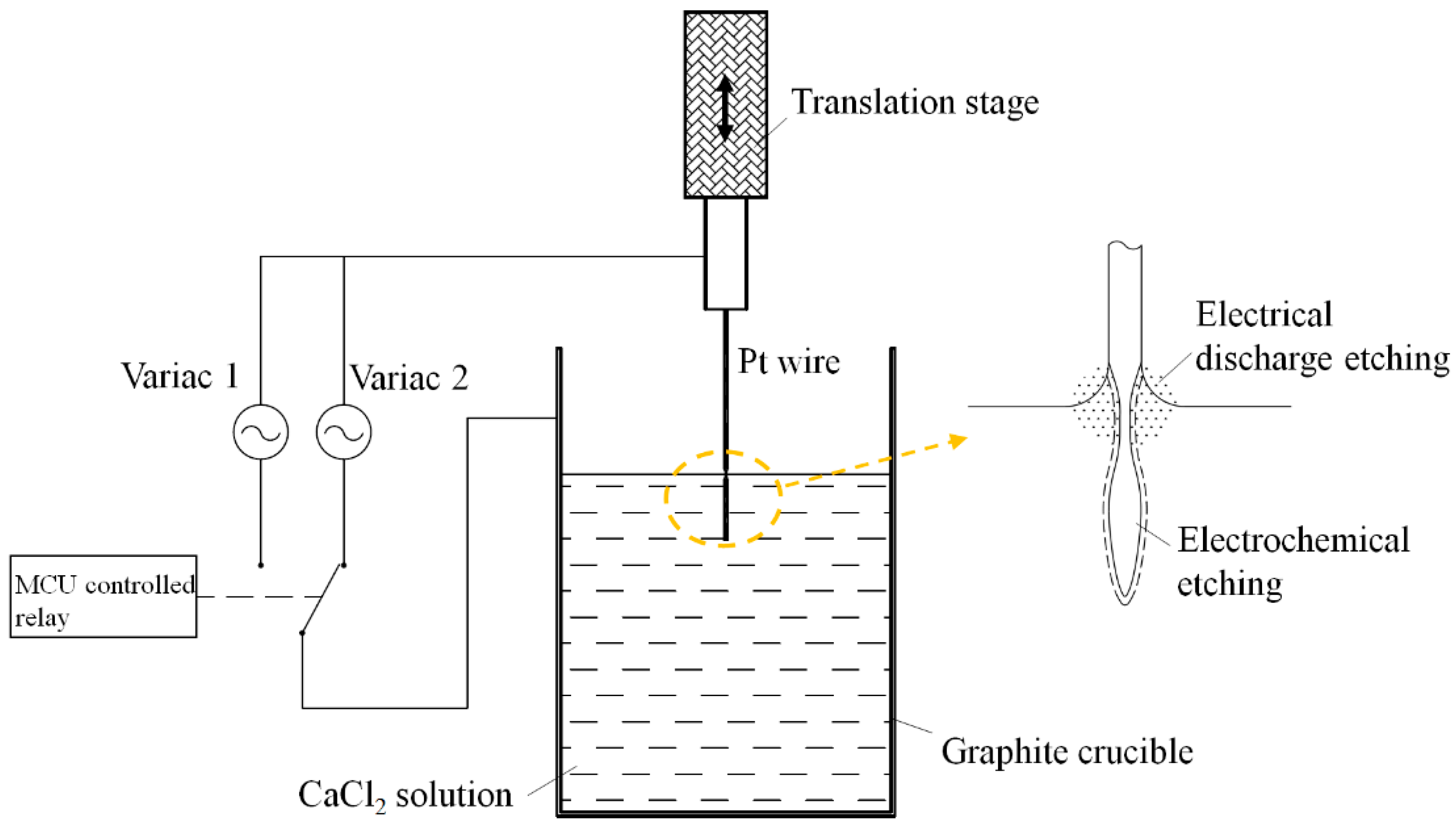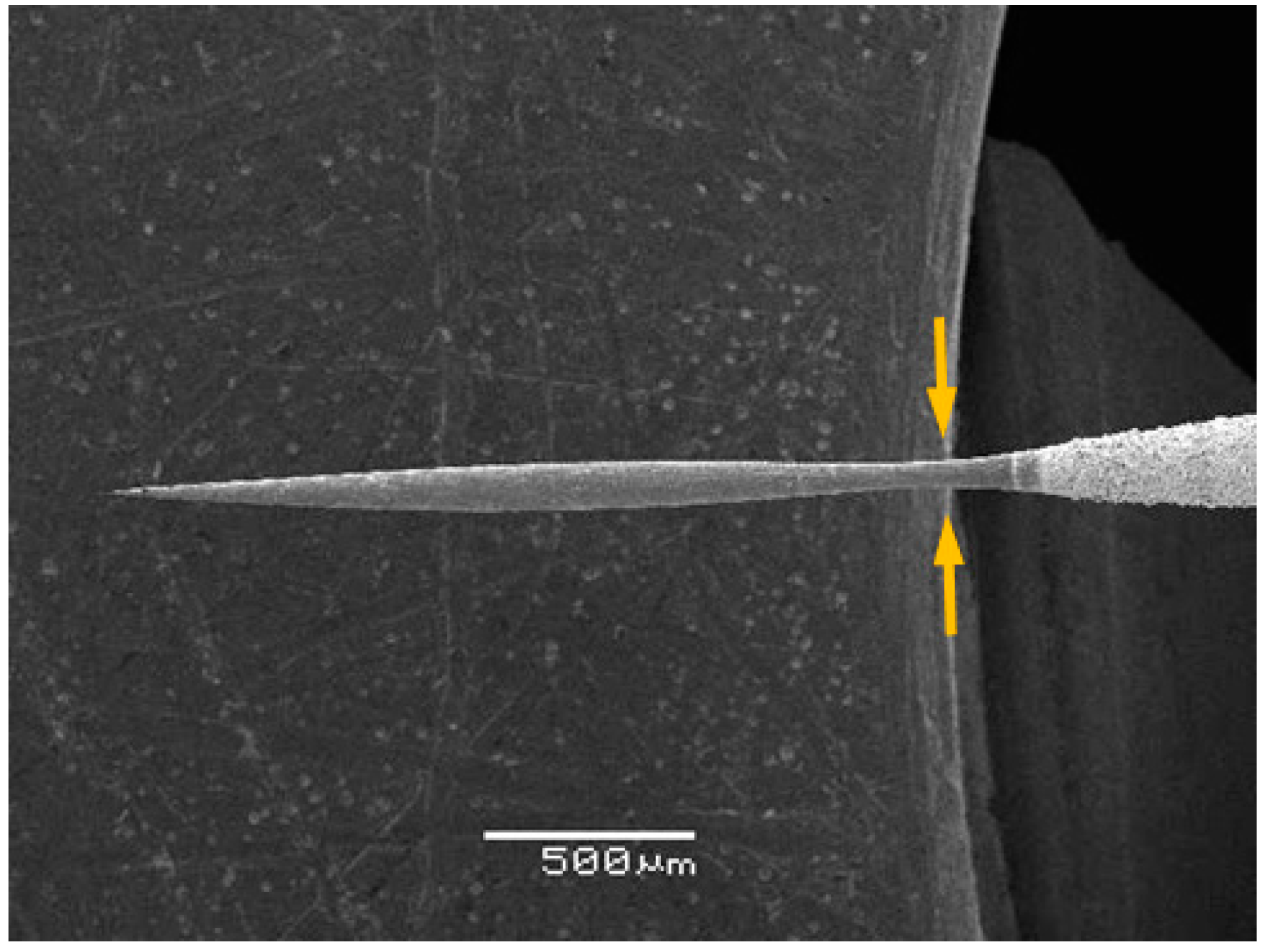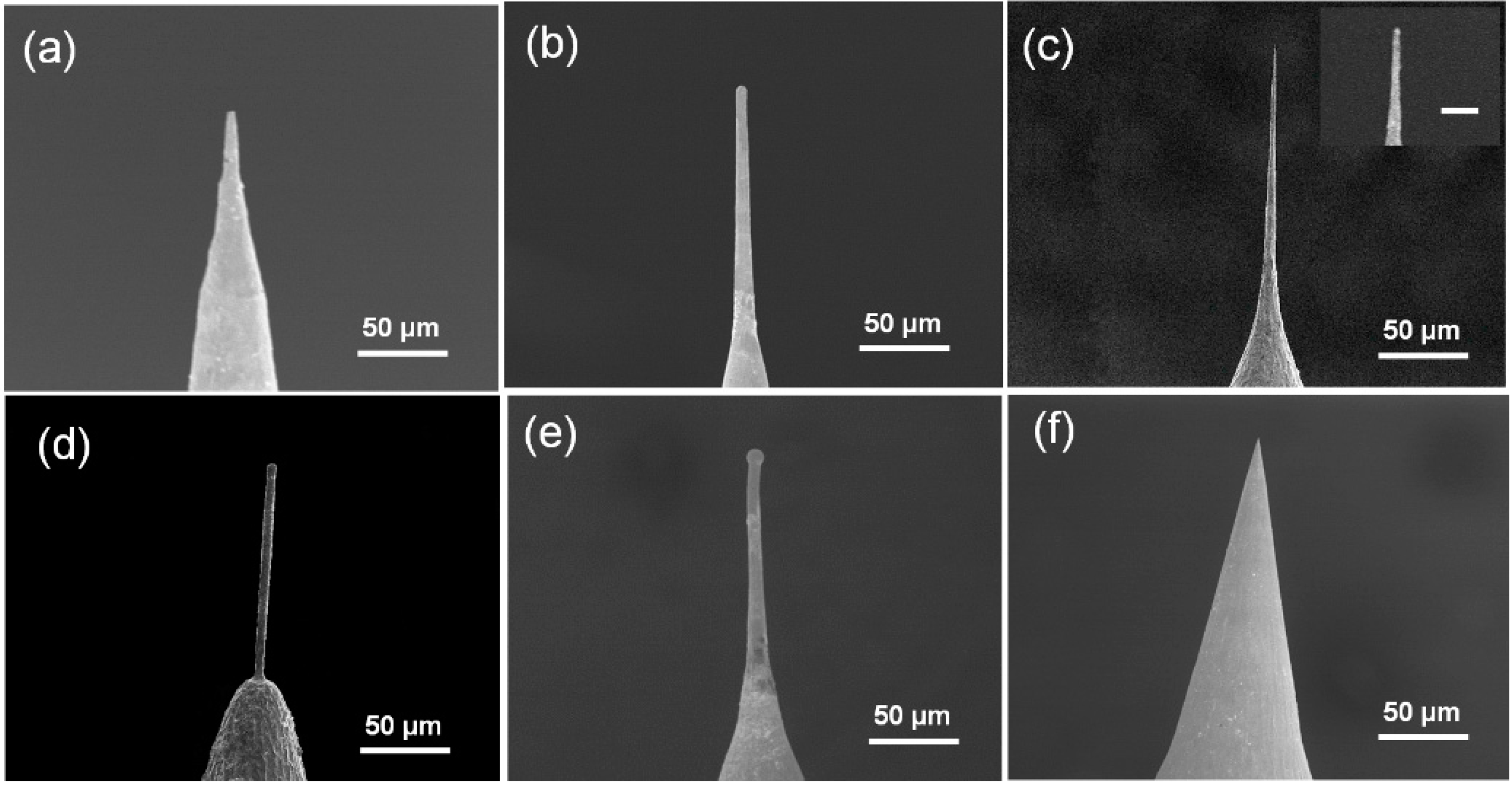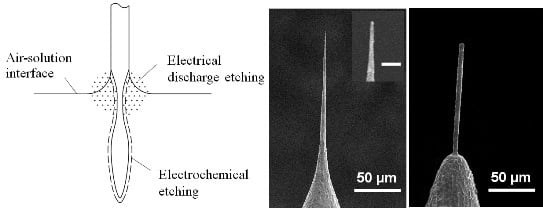Rapid Fabrication of High-Aspect-Ratio Platinum Microprobes by Electrochemical Discharge Etching
Abstract
:1. Introduction
2. Results and Discussion
3. Materials and Methods
4. Conclusions
Acknowledgments
Author Contributions
Conflicts of Interest
References
- Lu, Y.F.; Mai, Z.H.; Qiu, G.; Chim, W.K. Laser-Induced nano-oxidation on hydrogen-passivated Ge (100) surfaces under a scanning tunneling microscope tip. Appl. Phys. Lett. 1999, 75, 2359–2361. [Google Scholar] [CrossRef]
- Albonetti, C.; Bergenti, I.; Cavallini, M.; Dediu, V.; Massi, M.; Moulin, J.F.; Biscarini, F. Electrochemical preparation of cobalt tips for scanning tunneling microscopy. Rev. Sci. Instrum. 2002, 73, 4254–4256. [Google Scholar] [CrossRef]
- Cavallini, M.; Biscarini, F. Electrochemically etched nickel tips for spin polarized scanning tunneling microscopy. Rev. Sci. Instrum. 2000, 71, 4457–4460. [Google Scholar] [CrossRef]
- Rajurkara, K.P.; Sundaram, M.M.; Malshe, A.P. Review of electrochemical and electrodischarge machining. Procedia CIRP 2013, 6, 13–26. [Google Scholar] [CrossRef]
- Kamaraj, A.B.; Sundaram, M.M.; Mathew, R. Ultra high aspect ratio penetrating metal microelectrodes for biomedical applications. Microsyst. Technol. 2013, 19, 179–186. [Google Scholar] [CrossRef]
- Ibe, J.P.; Bey, P.P.; Brandow, S.L.; Brizzolara, R.A.; Burnham, N.A.; DiLella, D.P.; Lee, K.P.; Marrian, C.R.; Colton, R.J. On the electrochemical etching of tips for scanning tunneling microscopy. J. Vac. Sci. Technol. A 1990, 8, 3570–3575. [Google Scholar] [CrossRef]
- Walton, A.S.; Allen, C.S.; Critchley, K.; Gorzny, M.L.; Mc Kendy, J.E.; Brydson, R.M.D.; Hickey, B.J.; Evans, S.D. Four-probe electrical transport measurements on individual metallic nanowires. Nanotechnology 2007, 18. [Google Scholar] [CrossRef]
- Garnaes, J.; Kragh, F.; Mørch, K.A.; Tholen, A.R. Transmission electron-microscopy of scanning tunneling tips. J. Vac. Sci. Technol. A 1990, 8, 441–444. [Google Scholar] [CrossRef]
- Yakobson, Y.; Moyer, P.J.; Paesler, M.A. Kinetic limits for sensing tip morphology in near-field scanning optical microscopes. J. Appl. Phys. 1993, 73, 7984–7986. [Google Scholar] [CrossRef]
- Held, T.; Emonin, S.; Marti, O.; Hollricher, O. Method to produce high-resolution scanning near-field optical microscope probes by beveling optical fibers. Rev. Sci. Instrum. 2000, 71, 3118–3122. [Google Scholar] [CrossRef]
- Akiyama, K.; Eguchi, T.; An, T.; Fujikawa, Y.; Yamada-Takamura, Y.; Sakurai, T.; Hasegawa, Y. Development of a metal-tip cantilever for noncontact atomic force microscopy. Rev. Sci. Instrum. 2005, 76. [Google Scholar] [CrossRef]
- Onishi, K.; Guo, H.; Nagano, S.; Fujita, D. High aspect ratio AFM Probe processing by helium-ion-beam induced deposition. Microscopy 2014, 63 (Suppl. S1), i30. [Google Scholar] [CrossRef] [PubMed]
- Lindahl, J.; Takanen, T.; Montelius, L. Preparation and characterization of tungsten tips for scanning-tunneling-microscopy. J. Vac. Sci. Technol. B 1998, 16, 3077–3081. [Google Scholar] [CrossRef]
- Song, J.P.; Pryds, N.H.; Glejbøl, K.; Mørch, K.A.; Tholen, A.R.; Christensen, L.N. A development in the preparation of sharp scanning tunneling microscopy tips. Rev. Sci. Instrum. 1993, 64, 900–903. [Google Scholar] [CrossRef] [Green Version]
- Muramatsu, H.; Homma, K.; Chiba, N.; Yamamoto, N.; Egawa, A. Dynamic etching method for fabricating a variety of tip shapes in the optical fiber probe of a scanning near-field optical microscope. J. Microsc. 1999, 194, 383–387. [Google Scholar] [CrossRef] [PubMed]
- Melmed, A.J. The art and science and other aspects of making sharp tips. J. Vac. Sci. Technol. B 1991, 9, 601–608. [Google Scholar] [CrossRef]
- Cricenti, A.; Paparazzo, E.; Scarselli, M.A.; Moretto, L.; Selci, S. Preparation and characterization of tungsten tips for scanning-tunneling-microscopy. Rev. Sci. Instrum. 1994, 65, 1558–1560. [Google Scholar] [CrossRef]
- Quaade, U.J.; Oddershede, L. Electrochemical etching of sharp tips for STM reveals singularity. Europhys. Lett. 2002, 57, 611–617. [Google Scholar] [CrossRef]
- Rogers, B.L.; Shapter, J.G.; Skinner, W.M.; Gascoigne, K. A method for production of cheap, reliable Pt-Ir tips. Rev. Sci. Instrum. 2000, 71, 1702–1705. [Google Scholar] [CrossRef]
- Yi, Z.; Zhang, M. Fabrication of high-aspect-ratio platinum probes by two-step electrochemical etching. Rev. Sci. Instrum. 2015, 86. [Google Scholar] [CrossRef] [PubMed]
- Khan, Y.; Al-Falih, H.; Zhang, Y.; Ng, T.K.; Ooi, B.S. Two-step controllable electrochemical etching of tungsten scanning probe microscopy tips. Rev. Sci. Instrum. 2012, 83. [Google Scholar] [CrossRef] [PubMed]
- Toh, S.L.; Tan, H.; Lam, J.C.; Hsia, L.C.; Mai, Z.H. Optimization of AC electrochemical etching for fabricating tungsten nanotips with controlled tip profile. J. Electrochem. Soc. 2010, 157, e6–e11. [Google Scholar] [CrossRef]




| Yield Rate of Probes with Aspect Ratio Higher than 20 | Diameter of the Graphite Crucible (mm) | Voltage of the Second Step (V) |
|---|---|---|
| 40% (4 out of 10) | 20 | 20 |
| 83% (25 out of 30) | 30 | |
| 60% (6 out of 10) | 50 |
© 2016 by the authors; licensee MDPI, Basel, Switzerland. This article is an open access article distributed under the terms and conditions of the Creative Commons by Attribution (CC-BY) license (http://creativecommons.org/licenses/by/4.0/).
Share and Cite
Zhang, M.; Lian, X. Rapid Fabrication of High-Aspect-Ratio Platinum Microprobes by Electrochemical Discharge Etching. Materials 2016, 9, 233. https://doi.org/10.3390/ma9040233
Zhang M, Lian X. Rapid Fabrication of High-Aspect-Ratio Platinum Microprobes by Electrochemical Discharge Etching. Materials. 2016; 9(4):233. https://doi.org/10.3390/ma9040233
Chicago/Turabian StyleZhang, Min, and Xiangwei Lian. 2016. "Rapid Fabrication of High-Aspect-Ratio Platinum Microprobes by Electrochemical Discharge Etching" Materials 9, no. 4: 233. https://doi.org/10.3390/ma9040233






